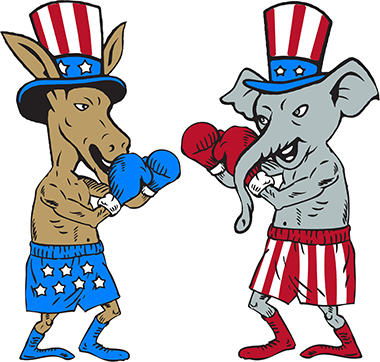Study: Democrats and Republicans Process Political Ads Differently
 |
|
A new study by UAlbany assistant communication professor Alyssa Morey reveals how Democrats and Republicans process political ads differently.
|
ALBANY, N.Y. (March 20, 2017) – Ask Democrats and Republicans which political advertisements they remember from November’s presidential election – their answer may surprise you.
Alyssa Morey, an assistant professor of communication at the University at Albany, has released a new study which finds that Republicans have a better memory of political television ads if the candidate is presented positively. Democrats are more likely to remember if the candidate is presented negatively.
Findings were published last month in Political Communication.
"This study is important, particularly because most theories on ideology and emotion, which propose a heightened sensitivity to negative emotions among conservatives, would seem to predict the opposite,” Morey said. “Much more research is required to understand the relationships among political orientation, emotion, and political processing.”
The study was conducted with 47 students who self-identified as either Republican or Democrat.
After watching a series of 30-second political ads, the students were asked to match the correct candidate with issues/stances that were discussed in the ad they were featured in. The students had six issues to choose from – three that were discussed during that candidate’s ad, three that were not.
Electroencephalography (EEG) recordings were also used to measure brain activity while participants watched the ads.
Results revealed a significant interaction between political ad type and partisanship.
“I thought that memory for positive and negative ads might depend on partisanship because a number of theories suggest that conservatism and liberalism are associated with different emotional orientations and sensitivities,” Morey said. “The role of brain activity in predicting political ad memory is very exciting, and shows a lot of potential for advancing our understanding of message processing in communication research.”
Morey has spent much of her career studying how our brain processes information. Political communication is the theme behind much of her research. Specifically, she’s interested in how individual differences influence the way we process political discussion and messages.
Previously, Morey co-authored a paper in Communication Research that used physiological recordings of peripheral nervous system measures (skin conductance, heart rate variability, facial electromyography) to examine selective processing of political ads.
“You can argue that political television ads are despised by almost everyone,” Morey said. “Despite their notoriety, these ads are an important source of information. Relative to other forms of political communication, they are more likely to reach the politically disengaged as well as partisans from both sides of the political aisle.”
In terms of November’s election, Morey said her research does not directly address the influence of political advertising on the campaigns of President Donald Trump or Hillary Clinton. However, it does offer some interesting talking points:
“Political ads can influence voters in many ways, and not always in the manner intended by the producers or sponsors of the ad,” Morey said. “In the case of this past election, positive Clinton ads might have had the opposite effect among some voters, either reducing support for Clinton or increasing support for Trump or a third party candidate.”
Morey earned a grant through the Drescher Leave Program last fall to assist with academic leave and focus on research. She credits the faculty in University’s Communications Department, including department chair Annis Golden, for their continued support and guidance.
You can learn more about Morey’s research by visiting her UAlbany faculty page.
![]() For more news, subscribe to UAlbany's RSS headline feeds
For more news, subscribe to UAlbany's RSS headline feeds
A comprehensive public research university, the University at Albany-SUNY offers more than 120 undergraduate majors and minors and 125 master's, doctoral and graduate certificate programs. UAlbany is a leader among all New York State colleges and universities in such diverse fields as atmospheric and environmental sciences, business, education, public health,health sciences, criminal justice, emergency preparedness, engineering and applied sciences, informatics, public administration, social welfare and sociology, taught by an extensive roster of faculty experts. It also offers expanded academic and research opportunities for students through an affiliation with Albany Law School. With a curriculum enhanced by 600 study-abroad opportunities, UAlbany launches great careers.


